Report on Developing Individuals, Teams and Organisations - HR
VerifiedAdded on 2020/06/06
|17
|4320
|32
Report
AI Summary
This report examines the crucial role of Human Resource Management (HRM) in fostering the development of individuals, teams, and the overall organization. It begins by identifying the essential knowledge, skills, and behaviors required of HR professionals, emphasizing organizational skills, communication, leadership, training and development, multitasking abilities, and conflict management. The report includes a detailed analysis of a personal skills audit and professional development plan for Jane Cambridge, highlighting areas of strength and weakness, and outlining steps for improvement. It then differentiates between organizational and individual learning, training, and development, emphasizing the importance of continuous learning and professional development for both individual growth and organizational success, including a discussion of Kolb's learning cycle. The report also explores the advantages of high-performance working and various approaches to performance management.
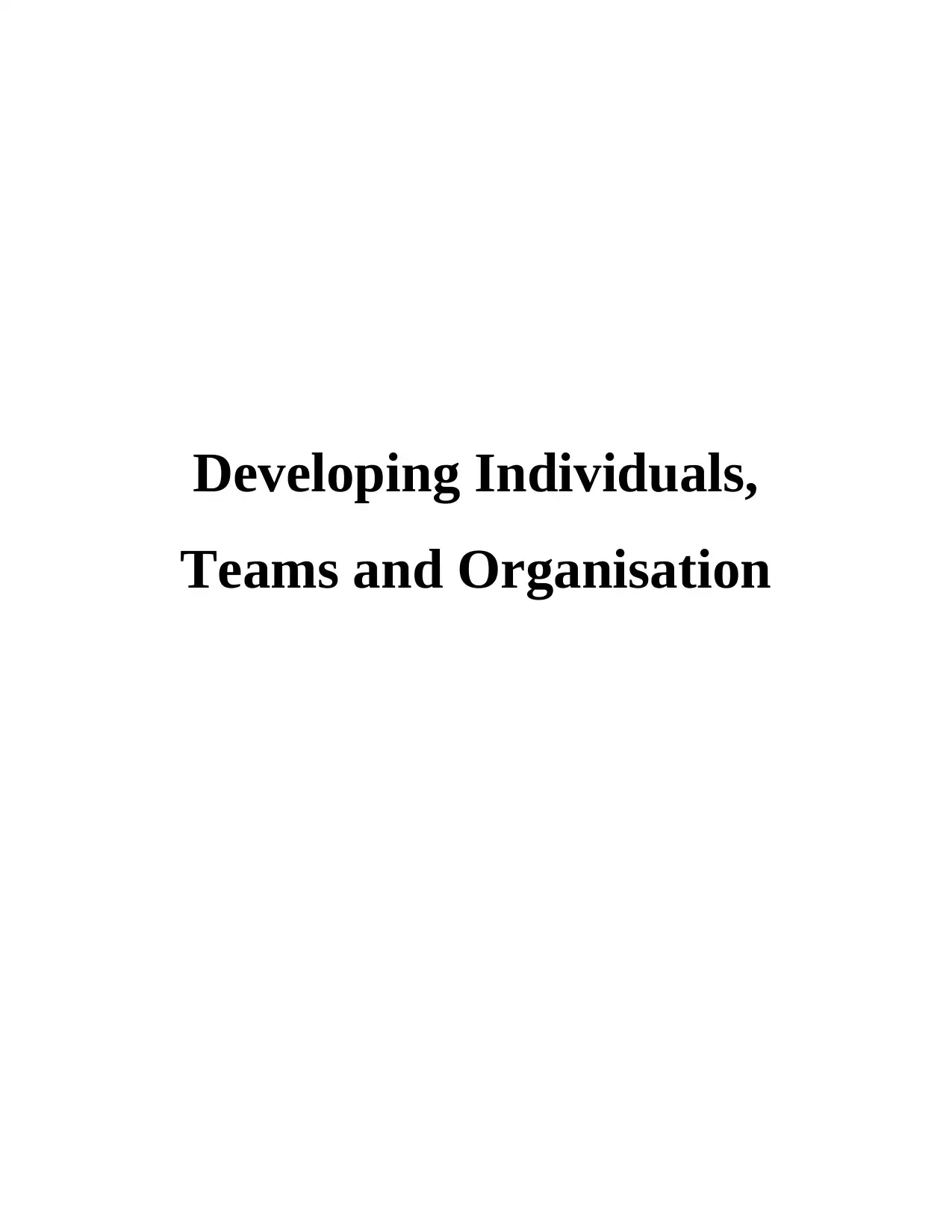
Developing Individuals,
Teams and Organisation
Teams and Organisation
Paraphrase This Document
Need a fresh take? Get an instant paraphrase of this document with our AI Paraphraser
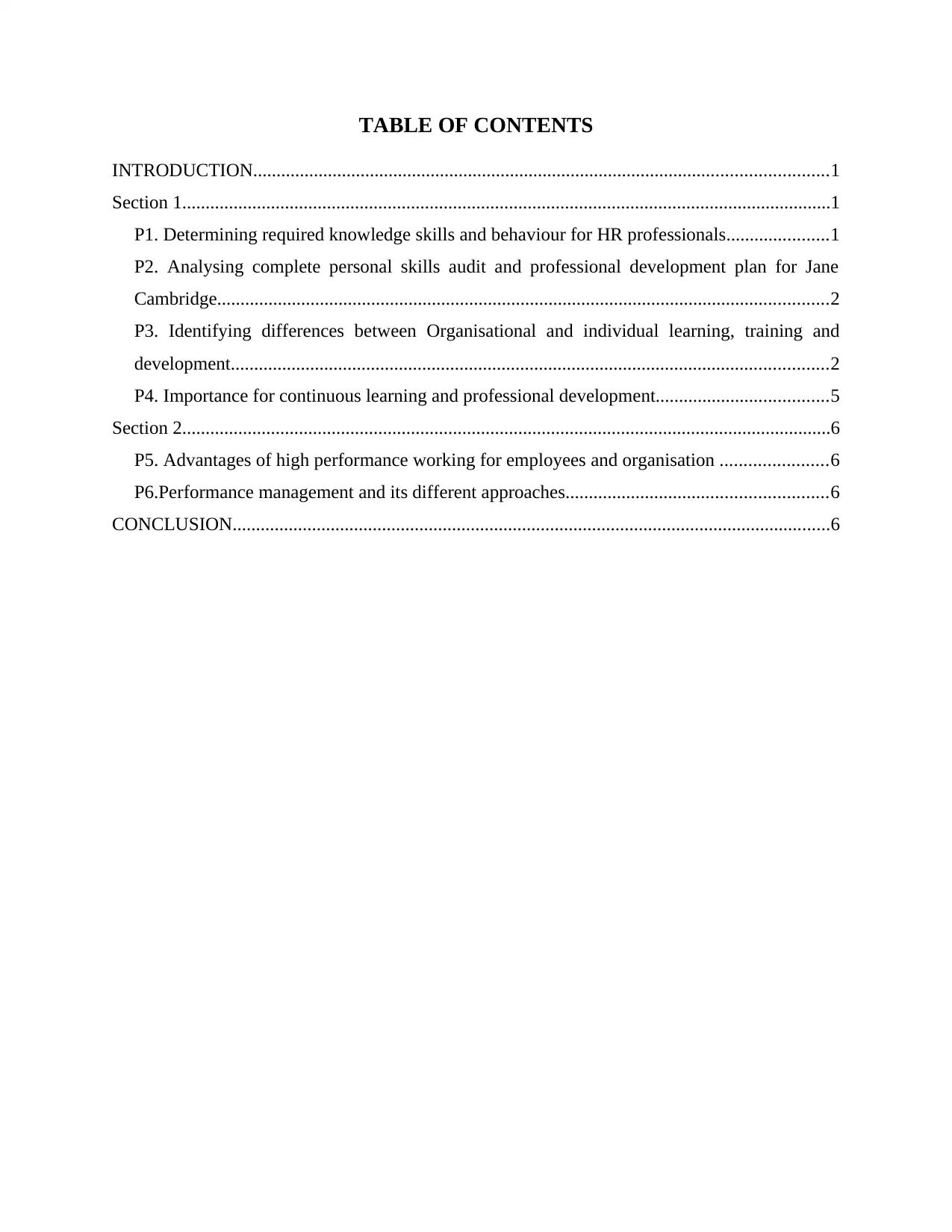
TABLE OF CONTENTS
INTRODUCTION...........................................................................................................................1
Section 1...........................................................................................................................................1
P1. Determining required knowledge skills and behaviour for HR professionals......................1
P2. Analysing complete personal skills audit and professional development plan for Jane
Cambridge...................................................................................................................................2
P3. Identifying differences between Organisational and individual learning, training and
development................................................................................................................................2
P4. Importance for continuous learning and professional development.....................................5
Section 2...........................................................................................................................................6
P5. Advantages of high performance working for employees and organisation .......................6
P6.Performance management and its different approaches........................................................6
CONCLUSION................................................................................................................................6
INTRODUCTION...........................................................................................................................1
Section 1...........................................................................................................................................1
P1. Determining required knowledge skills and behaviour for HR professionals......................1
P2. Analysing complete personal skills audit and professional development plan for Jane
Cambridge...................................................................................................................................2
P3. Identifying differences between Organisational and individual learning, training and
development................................................................................................................................2
P4. Importance for continuous learning and professional development.....................................5
Section 2...........................................................................................................................................6
P5. Advantages of high performance working for employees and organisation .......................6
P6.Performance management and its different approaches........................................................6
CONCLUSION................................................................................................................................6
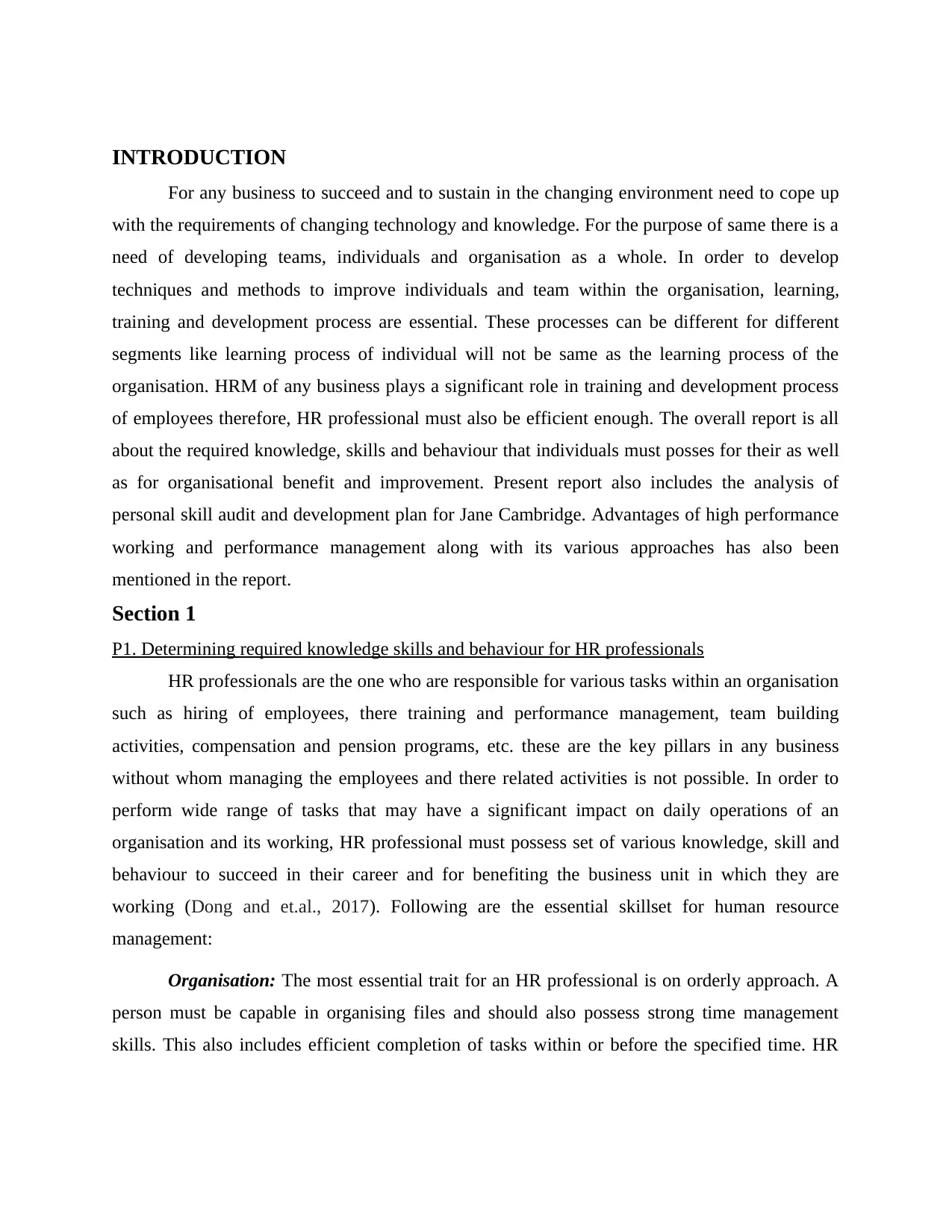
INTRODUCTION
For any business to succeed and to sustain in the changing environment need to cope up
with the requirements of changing technology and knowledge. For the purpose of same there is a
need of developing teams, individuals and organisation as a whole. In order to develop
techniques and methods to improve individuals and team within the organisation, learning,
training and development process are essential. These processes can be different for different
segments like learning process of individual will not be same as the learning process of the
organisation. HRM of any business plays a significant role in training and development process
of employees therefore, HR professional must also be efficient enough. The overall report is all
about the required knowledge, skills and behaviour that individuals must posses for their as well
as for organisational benefit and improvement. Present report also includes the analysis of
personal skill audit and development plan for Jane Cambridge. Advantages of high performance
working and performance management along with its various approaches has also been
mentioned in the report.
Section 1
P1. Determining required knowledge skills and behaviour for HR professionals
HR professionals are the one who are responsible for various tasks within an organisation
such as hiring of employees, there training and performance management, team building
activities, compensation and pension programs, etc. these are the key pillars in any business
without whom managing the employees and there related activities is not possible. In order to
perform wide range of tasks that may have a significant impact on daily operations of an
organisation and its working, HR professional must possess set of various knowledge, skill and
behaviour to succeed in their career and for benefiting the business unit in which they are
working (Dong and et.al., 2017). Following are the essential skillset for human resource
management:
Organisation: The most essential trait for an HR professional is on orderly approach. A
person must be capable in organising files and should also possess strong time management
skills. This also includes efficient completion of tasks within or before the specified time. HR
For any business to succeed and to sustain in the changing environment need to cope up
with the requirements of changing technology and knowledge. For the purpose of same there is a
need of developing teams, individuals and organisation as a whole. In order to develop
techniques and methods to improve individuals and team within the organisation, learning,
training and development process are essential. These processes can be different for different
segments like learning process of individual will not be same as the learning process of the
organisation. HRM of any business plays a significant role in training and development process
of employees therefore, HR professional must also be efficient enough. The overall report is all
about the required knowledge, skills and behaviour that individuals must posses for their as well
as for organisational benefit and improvement. Present report also includes the analysis of
personal skill audit and development plan for Jane Cambridge. Advantages of high performance
working and performance management along with its various approaches has also been
mentioned in the report.
Section 1
P1. Determining required knowledge skills and behaviour for HR professionals
HR professionals are the one who are responsible for various tasks within an organisation
such as hiring of employees, there training and performance management, team building
activities, compensation and pension programs, etc. these are the key pillars in any business
without whom managing the employees and there related activities is not possible. In order to
perform wide range of tasks that may have a significant impact on daily operations of an
organisation and its working, HR professional must possess set of various knowledge, skill and
behaviour to succeed in their career and for benefiting the business unit in which they are
working (Dong and et.al., 2017). Following are the essential skillset for human resource
management:
Organisation: The most essential trait for an HR professional is on orderly approach. A
person must be capable in organising files and should also possess strong time management
skills. This also includes efficient completion of tasks within or before the specified time. HR
⊘ This is a preview!⊘
Do you want full access?
Subscribe today to unlock all pages.

Trusted by 1+ million students worldwide
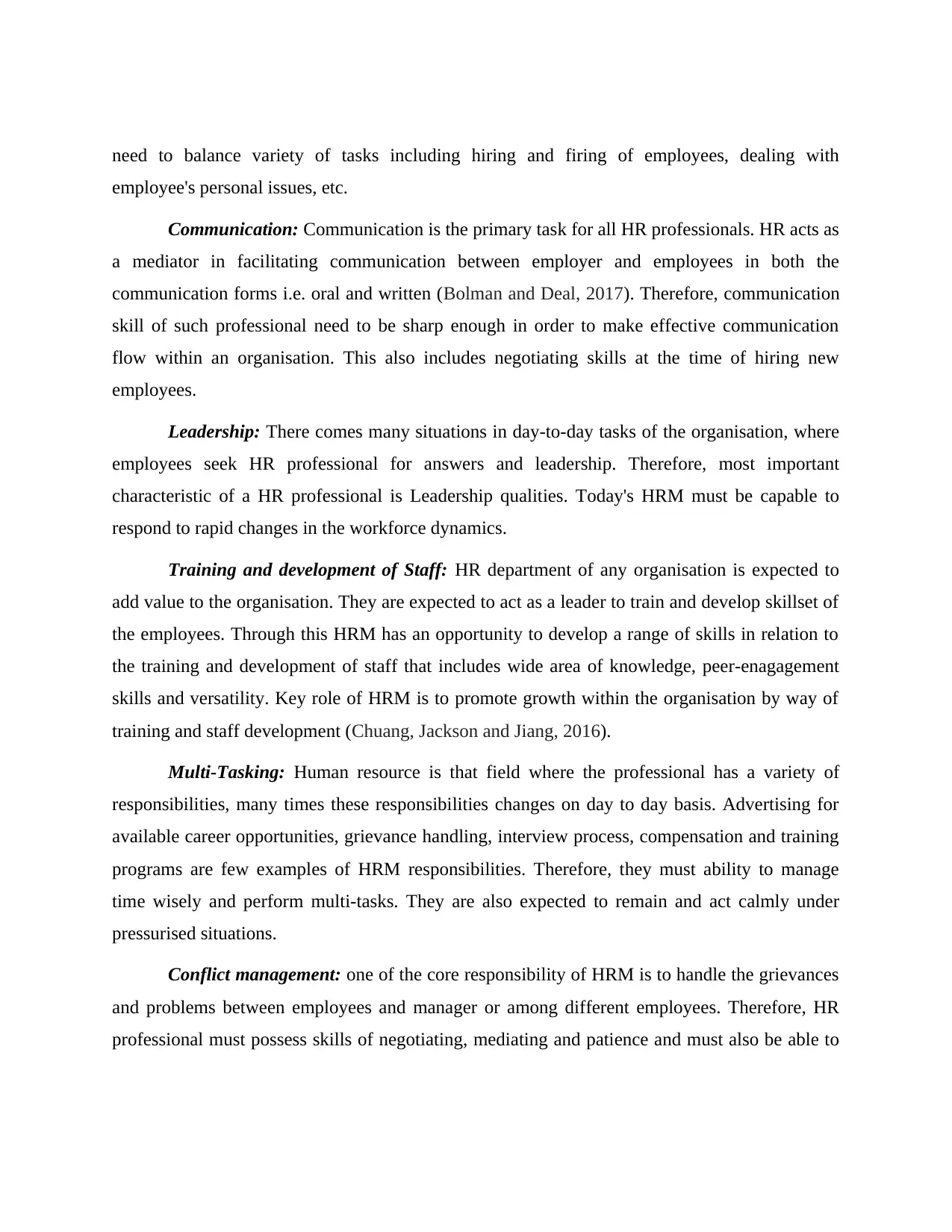
need to balance variety of tasks including hiring and firing of employees, dealing with
employee's personal issues, etc.
Communication: Communication is the primary task for all HR professionals. HR acts as
a mediator in facilitating communication between employer and employees in both the
communication forms i.e. oral and written (Bolman and Deal, 2017). Therefore, communication
skill of such professional need to be sharp enough in order to make effective communication
flow within an organisation. This also includes negotiating skills at the time of hiring new
employees.
Leadership: There comes many situations in day-to-day tasks of the organisation, where
employees seek HR professional for answers and leadership. Therefore, most important
characteristic of a HR professional is Leadership qualities. Today's HRM must be capable to
respond to rapid changes in the workforce dynamics.
Training and development of Staff: HR department of any organisation is expected to
add value to the organisation. They are expected to act as a leader to train and develop skillset of
the employees. Through this HRM has an opportunity to develop a range of skills in relation to
the training and development of staff that includes wide area of knowledge, peer-enagagement
skills and versatility. Key role of HRM is to promote growth within the organisation by way of
training and staff development (Chuang, Jackson and Jiang, 2016).
Multi-Tasking: Human resource is that field where the professional has a variety of
responsibilities, many times these responsibilities changes on day to day basis. Advertising for
available career opportunities, grievance handling, interview process, compensation and training
programs are few examples of HRM responsibilities. Therefore, they must ability to manage
time wisely and perform multi-tasks. They are also expected to remain and act calmly under
pressurised situations.
Conflict management: one of the core responsibility of HRM is to handle the grievances
and problems between employees and manager or among different employees. Therefore, HR
professional must possess skills of negotiating, mediating and patience and must also be able to
employee's personal issues, etc.
Communication: Communication is the primary task for all HR professionals. HR acts as
a mediator in facilitating communication between employer and employees in both the
communication forms i.e. oral and written (Bolman and Deal, 2017). Therefore, communication
skill of such professional need to be sharp enough in order to make effective communication
flow within an organisation. This also includes negotiating skills at the time of hiring new
employees.
Leadership: There comes many situations in day-to-day tasks of the organisation, where
employees seek HR professional for answers and leadership. Therefore, most important
characteristic of a HR professional is Leadership qualities. Today's HRM must be capable to
respond to rapid changes in the workforce dynamics.
Training and development of Staff: HR department of any organisation is expected to
add value to the organisation. They are expected to act as a leader to train and develop skillset of
the employees. Through this HRM has an opportunity to develop a range of skills in relation to
the training and development of staff that includes wide area of knowledge, peer-enagagement
skills and versatility. Key role of HRM is to promote growth within the organisation by way of
training and staff development (Chuang, Jackson and Jiang, 2016).
Multi-Tasking: Human resource is that field where the professional has a variety of
responsibilities, many times these responsibilities changes on day to day basis. Advertising for
available career opportunities, grievance handling, interview process, compensation and training
programs are few examples of HRM responsibilities. Therefore, they must ability to manage
time wisely and perform multi-tasks. They are also expected to remain and act calmly under
pressurised situations.
Conflict management: one of the core responsibility of HRM is to handle the grievances
and problems between employees and manager or among different employees. Therefore, HR
professional must possess skills of negotiating, mediating and patience and must also be able to
Paraphrase This Document
Need a fresh take? Get an instant paraphrase of this document with our AI Paraphraser
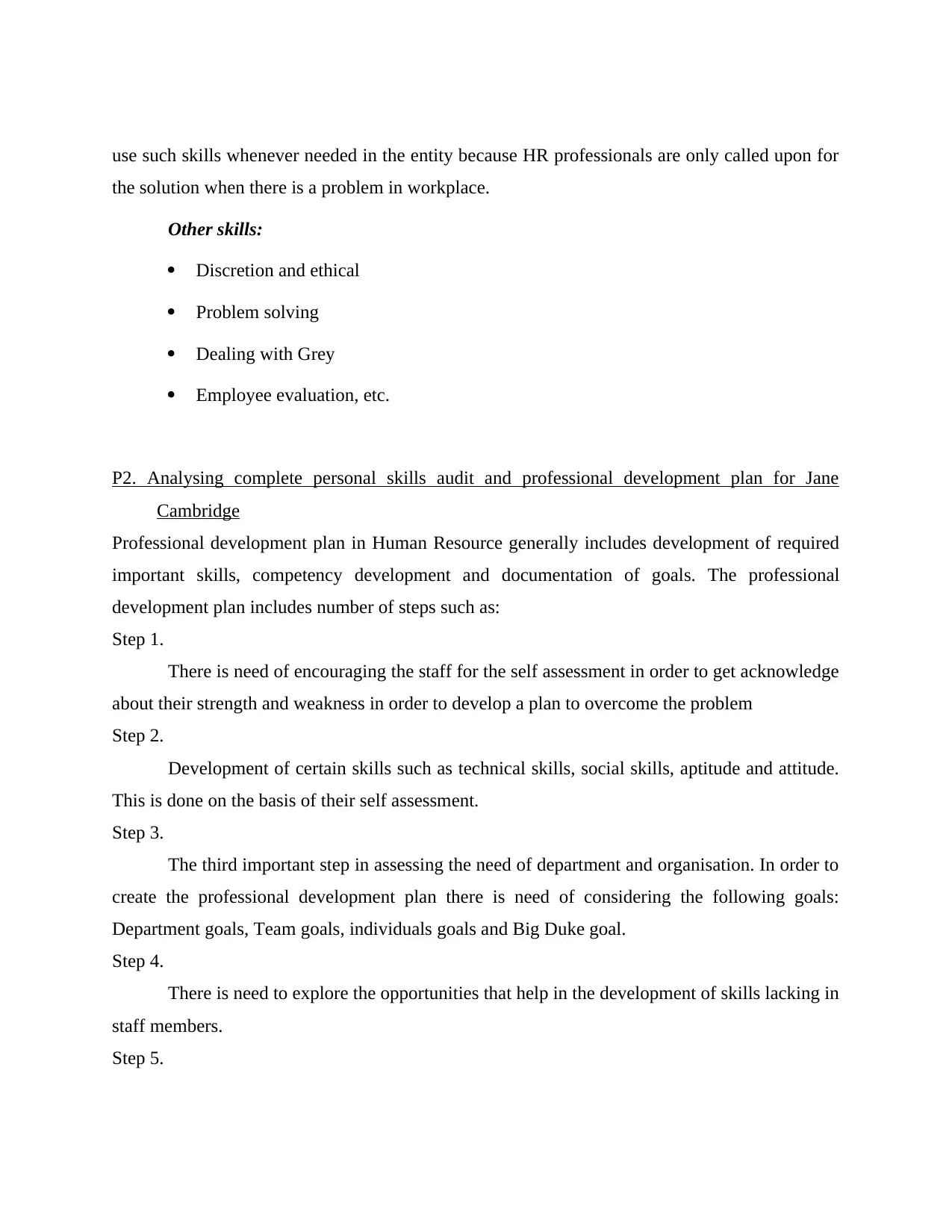
use such skills whenever needed in the entity because HR professionals are only called upon for
the solution when there is a problem in workplace.
Other skills:
Discretion and ethical
Problem solving
Dealing with Grey
Employee evaluation, etc.
P2. Analysing complete personal skills audit and professional development plan for Jane
Cambridge
Professional development plan in Human Resource generally includes development of required
important skills, competency development and documentation of goals. The professional
development plan includes number of steps such as:
Step 1.
There is need of encouraging the staff for the self assessment in order to get acknowledge
about their strength and weakness in order to develop a plan to overcome the problem
Step 2.
Development of certain skills such as technical skills, social skills, aptitude and attitude.
This is done on the basis of their self assessment.
Step 3.
The third important step in assessing the need of department and organisation. In order to
create the professional development plan there is need of considering the following goals:
Department goals, Team goals, individuals goals and Big Duke goal.
Step 4.
There is need to explore the opportunities that help in the development of skills lacking in
staff members.
Step 5.
the solution when there is a problem in workplace.
Other skills:
Discretion and ethical
Problem solving
Dealing with Grey
Employee evaluation, etc.
P2. Analysing complete personal skills audit and professional development plan for Jane
Cambridge
Professional development plan in Human Resource generally includes development of required
important skills, competency development and documentation of goals. The professional
development plan includes number of steps such as:
Step 1.
There is need of encouraging the staff for the self assessment in order to get acknowledge
about their strength and weakness in order to develop a plan to overcome the problem
Step 2.
Development of certain skills such as technical skills, social skills, aptitude and attitude.
This is done on the basis of their self assessment.
Step 3.
The third important step in assessing the need of department and organisation. In order to
create the professional development plan there is need of considering the following goals:
Department goals, Team goals, individuals goals and Big Duke goal.
Step 4.
There is need to explore the opportunities that help in the development of skills lacking in
staff members.
Step 5.
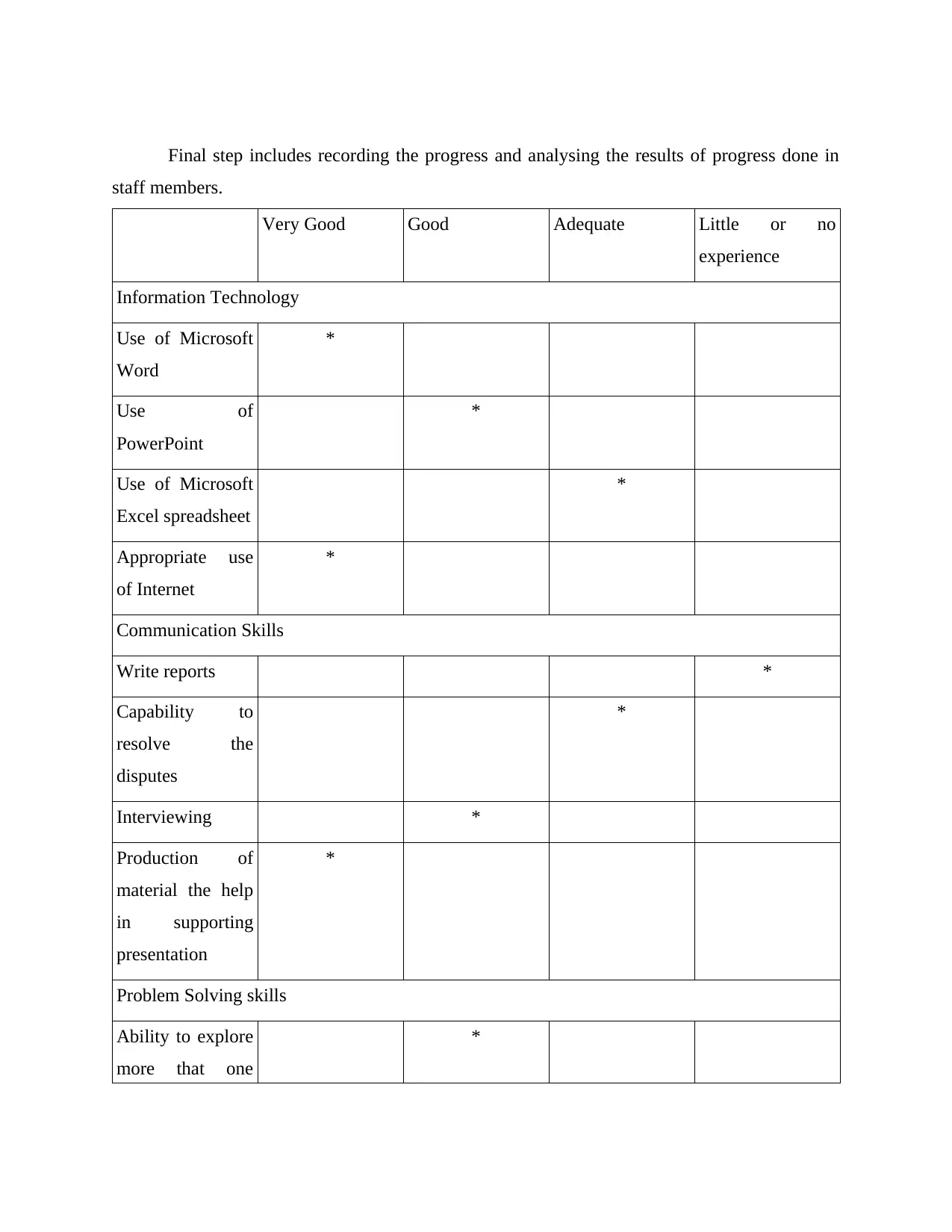
Final step includes recording the progress and analysing the results of progress done in
staff members.
Very Good Good Adequate Little or no
experience
Information Technology
Use of Microsoft
Word
*
Use of
PowerPoint
*
Use of Microsoft
Excel spreadsheet
*
Appropriate use
of Internet
*
Communication Skills
Write reports *
Capability to
resolve the
disputes
*
Interviewing *
Production of
material the help
in supporting
presentation
*
Problem Solving skills
Ability to explore
more that one
*
staff members.
Very Good Good Adequate Little or no
experience
Information Technology
Use of Microsoft
Word
*
Use of
PowerPoint
*
Use of Microsoft
Excel spreadsheet
*
Appropriate use
of Internet
*
Communication Skills
Write reports *
Capability to
resolve the
disputes
*
Interviewing *
Production of
material the help
in supporting
presentation
*
Problem Solving skills
Ability to explore
more that one
*
⊘ This is a preview!⊘
Do you want full access?
Subscribe today to unlock all pages.

Trusted by 1+ million students worldwide
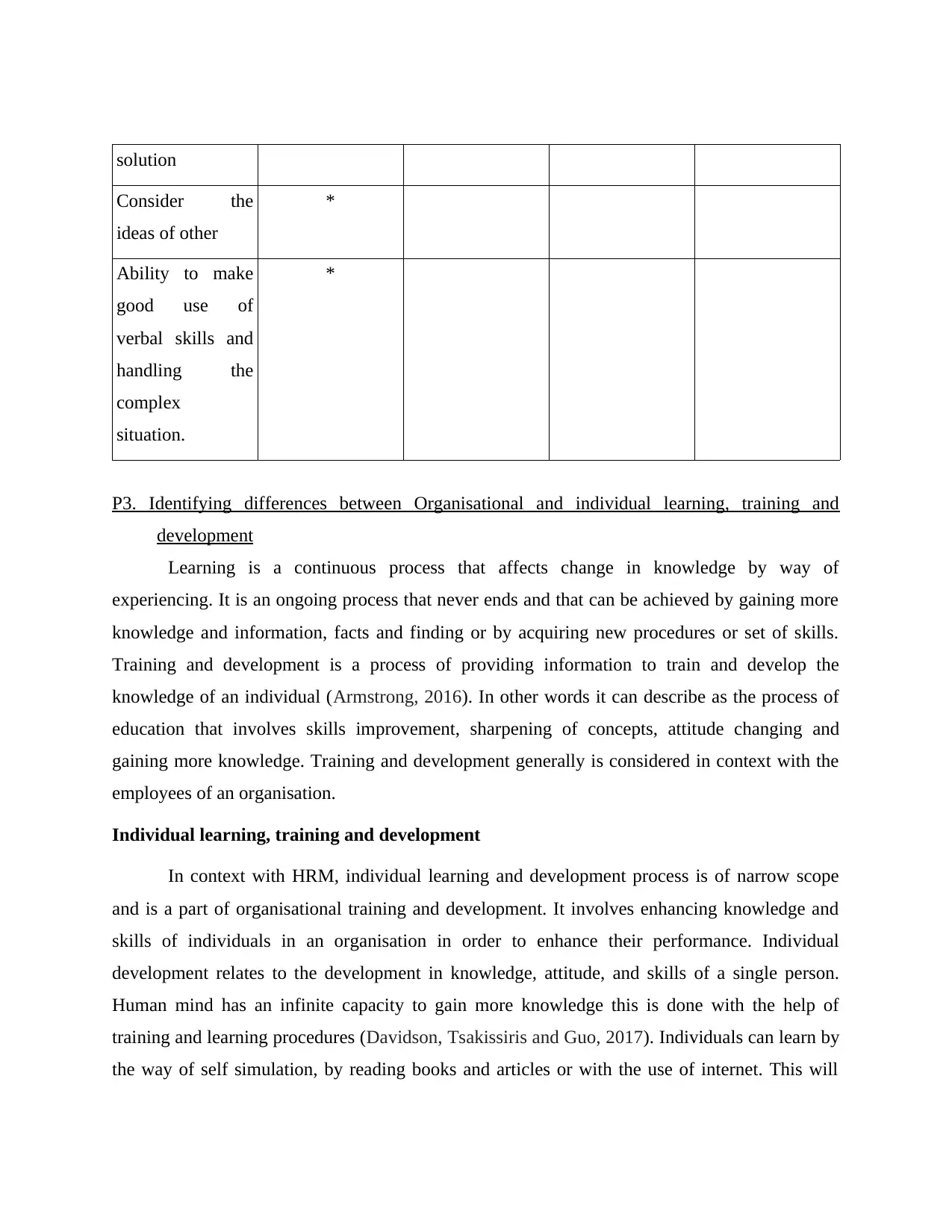
solution
Consider the
ideas of other
*
Ability to make
good use of
verbal skills and
handling the
complex
situation.
*
P3. Identifying differences between Organisational and individual learning, training and
development
Learning is a continuous process that affects change in knowledge by way of
experiencing. It is an ongoing process that never ends and that can be achieved by gaining more
knowledge and information, facts and finding or by acquiring new procedures or set of skills.
Training and development is a process of providing information to train and develop the
knowledge of an individual (Armstrong, 2016). In other words it can describe as the process of
education that involves skills improvement, sharpening of concepts, attitude changing and
gaining more knowledge. Training and development generally is considered in context with the
employees of an organisation.
Individual learning, training and development
In context with HRM, individual learning and development process is of narrow scope
and is a part of organisational training and development. It involves enhancing knowledge and
skills of individuals in an organisation in order to enhance their performance. Individual
development relates to the development in knowledge, attitude, and skills of a single person.
Human mind has an infinite capacity to gain more knowledge this is done with the help of
training and learning procedures (Davidson, Tsakissiris and Guo, 2017). Individuals can learn by
the way of self simulation, by reading books and articles or with the use of internet. This will
Consider the
ideas of other
*
Ability to make
good use of
verbal skills and
handling the
complex
situation.
*
P3. Identifying differences between Organisational and individual learning, training and
development
Learning is a continuous process that affects change in knowledge by way of
experiencing. It is an ongoing process that never ends and that can be achieved by gaining more
knowledge and information, facts and finding or by acquiring new procedures or set of skills.
Training and development is a process of providing information to train and develop the
knowledge of an individual (Armstrong, 2016). In other words it can describe as the process of
education that involves skills improvement, sharpening of concepts, attitude changing and
gaining more knowledge. Training and development generally is considered in context with the
employees of an organisation.
Individual learning, training and development
In context with HRM, individual learning and development process is of narrow scope
and is a part of organisational training and development. It involves enhancing knowledge and
skills of individuals in an organisation in order to enhance their performance. Individual
development relates to the development in knowledge, attitude, and skills of a single person.
Human mind has an infinite capacity to gain more knowledge this is done with the help of
training and learning procedures (Davidson, Tsakissiris and Guo, 2017). Individuals can learn by
the way of self simulation, by reading books and articles or with the use of internet. This will
Paraphrase This Document
Need a fresh take? Get an instant paraphrase of this document with our AI Paraphraser
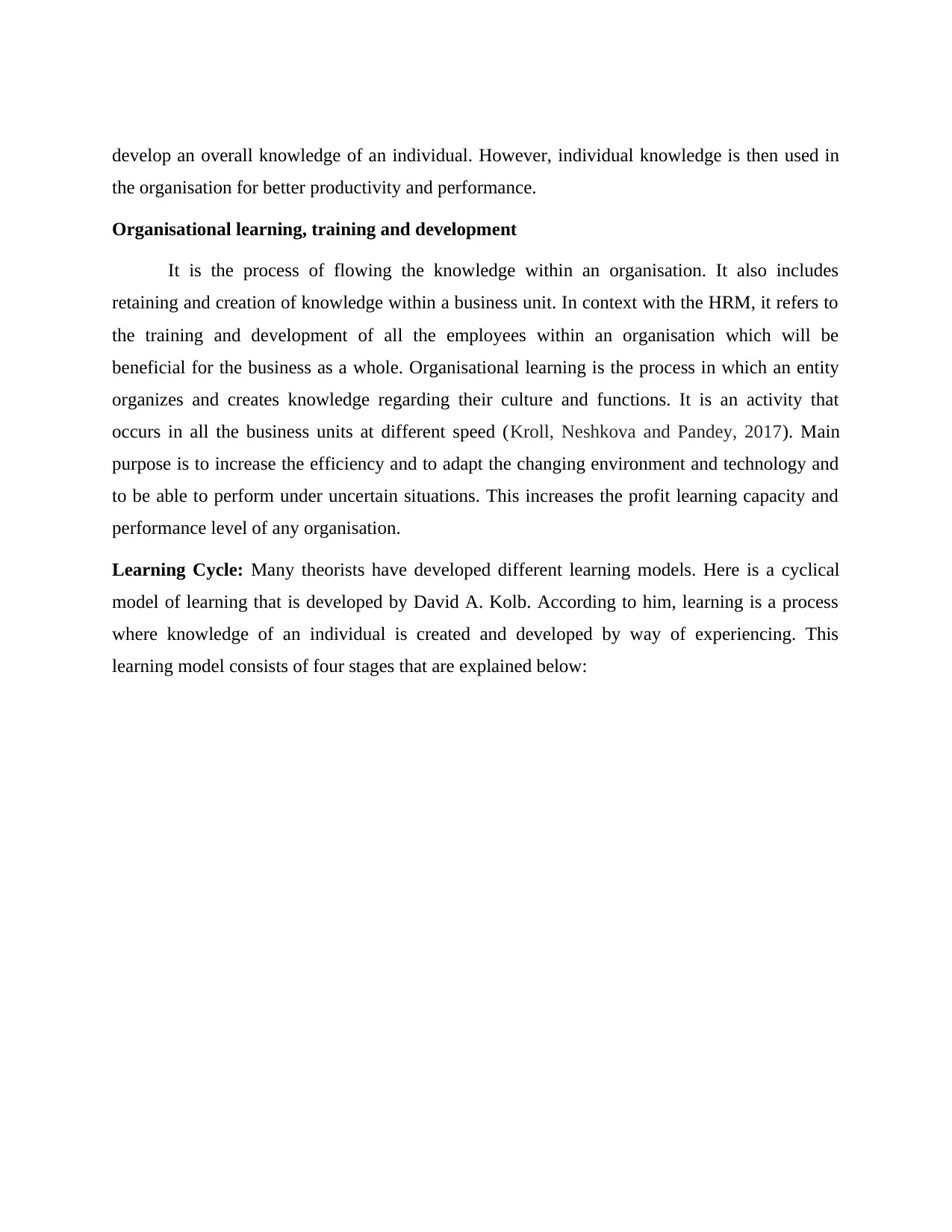
develop an overall knowledge of an individual. However, individual knowledge is then used in
the organisation for better productivity and performance.
Organisational learning, training and development
It is the process of flowing the knowledge within an organisation. It also includes
retaining and creation of knowledge within a business unit. In context with the HRM, it refers to
the training and development of all the employees within an organisation which will be
beneficial for the business as a whole. Organisational learning is the process in which an entity
organizes and creates knowledge regarding their culture and functions. It is an activity that
occurs in all the business units at different speed (Kroll, Neshkova and Pandey, 2017). Main
purpose is to increase the efficiency and to adapt the changing environment and technology and
to be able to perform under uncertain situations. This increases the profit learning capacity and
performance level of any organisation.
Learning Cycle: Many theorists have developed different learning models. Here is a cyclical
model of learning that is developed by David A. Kolb. According to him, learning is a process
where knowledge of an individual is created and developed by way of experiencing. This
learning model consists of four stages that are explained below:
the organisation for better productivity and performance.
Organisational learning, training and development
It is the process of flowing the knowledge within an organisation. It also includes
retaining and creation of knowledge within a business unit. In context with the HRM, it refers to
the training and development of all the employees within an organisation which will be
beneficial for the business as a whole. Organisational learning is the process in which an entity
organizes and creates knowledge regarding their culture and functions. It is an activity that
occurs in all the business units at different speed (Kroll, Neshkova and Pandey, 2017). Main
purpose is to increase the efficiency and to adapt the changing environment and technology and
to be able to perform under uncertain situations. This increases the profit learning capacity and
performance level of any organisation.
Learning Cycle: Many theorists have developed different learning models. Here is a cyclical
model of learning that is developed by David A. Kolb. According to him, learning is a process
where knowledge of an individual is created and developed by way of experiencing. This
learning model consists of four stages that are explained below:
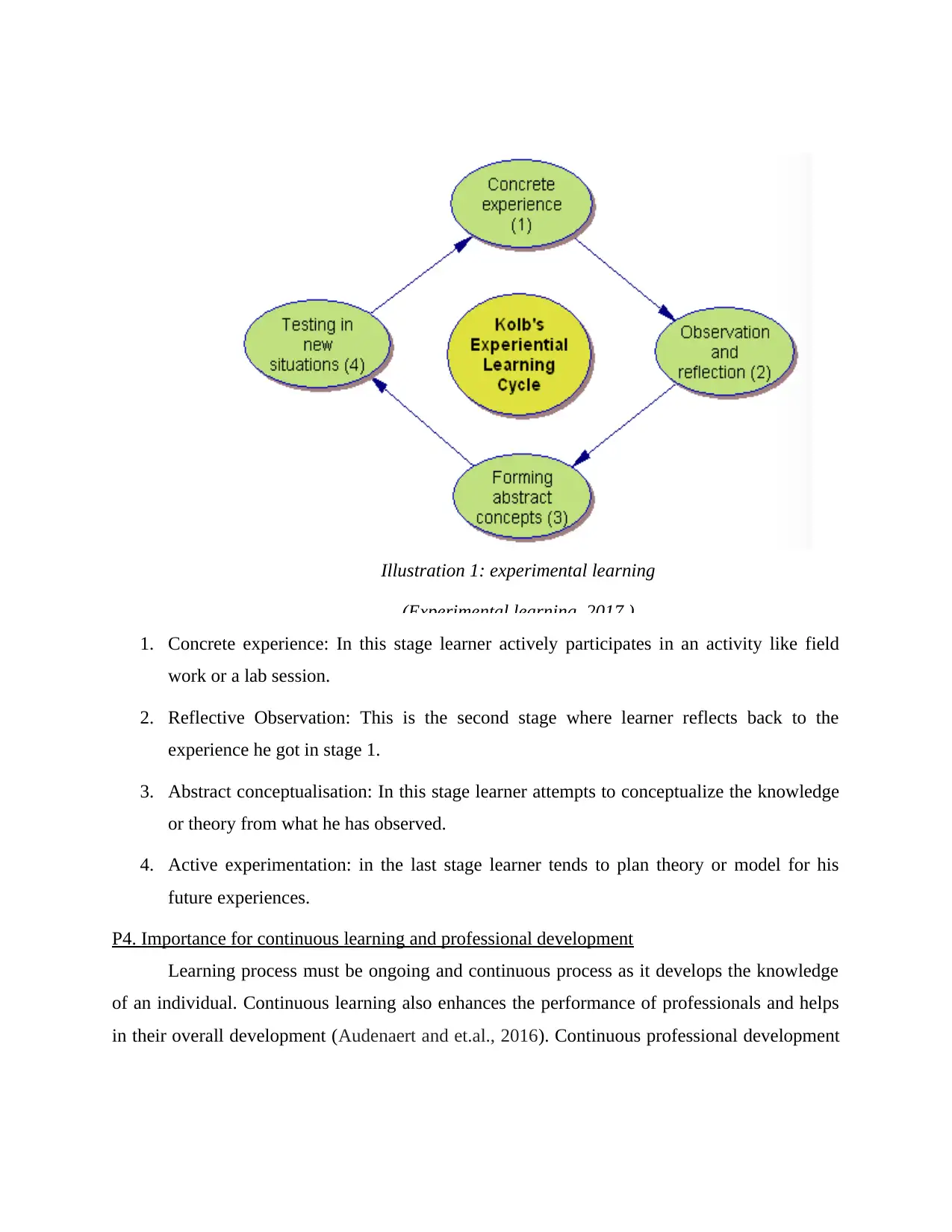
Illustration 1: experimental learning
(Experimental learning, 2017 )
1. Concrete experience: In this stage learner actively participates in an activity like field
work or a lab session.
2. Reflective Observation: This is the second stage where learner reflects back to the
experience he got in stage 1.
3. Abstract conceptualisation: In this stage learner attempts to conceptualize the knowledge
or theory from what he has observed.
4. Active experimentation: in the last stage learner tends to plan theory or model for his
future experiences.
P4. Importance for continuous learning and professional development
Learning process must be ongoing and continuous process as it develops the knowledge
of an individual. Continuous learning also enhances the performance of professionals and helps
in their overall development (Audenaert and et.al., 2016). Continuous professional development
(Experimental learning, 2017 )
1. Concrete experience: In this stage learner actively participates in an activity like field
work or a lab session.
2. Reflective Observation: This is the second stage where learner reflects back to the
experience he got in stage 1.
3. Abstract conceptualisation: In this stage learner attempts to conceptualize the knowledge
or theory from what he has observed.
4. Active experimentation: in the last stage learner tends to plan theory or model for his
future experiences.
P4. Importance for continuous learning and professional development
Learning process must be ongoing and continuous process as it develops the knowledge
of an individual. Continuous learning also enhances the performance of professionals and helps
in their overall development (Audenaert and et.al., 2016). Continuous professional development
⊘ This is a preview!⊘
Do you want full access?
Subscribe today to unlock all pages.

Trusted by 1+ million students worldwide
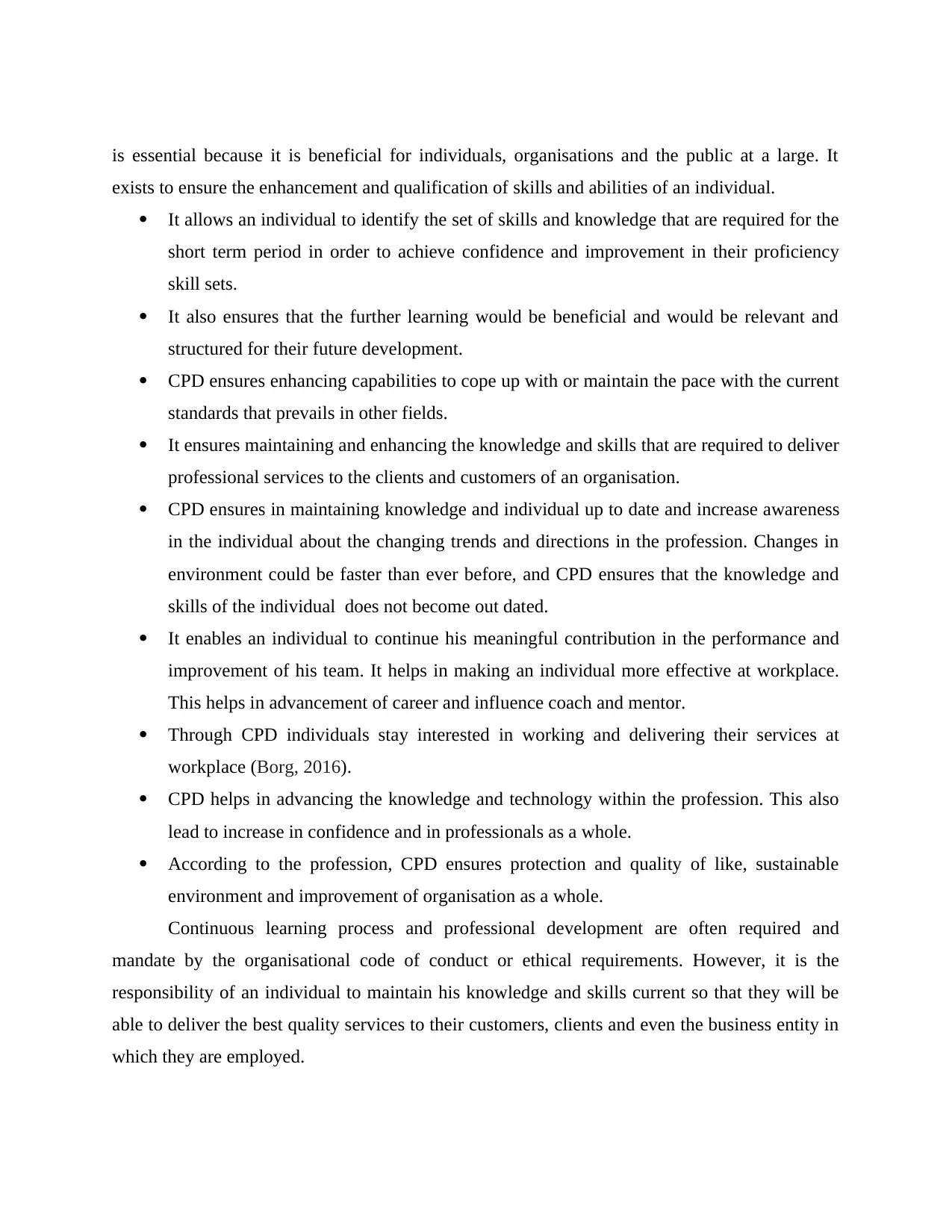
is essential because it is beneficial for individuals, organisations and the public at a large. It
exists to ensure the enhancement and qualification of skills and abilities of an individual.
It allows an individual to identify the set of skills and knowledge that are required for the
short term period in order to achieve confidence and improvement in their proficiency
skill sets.
It also ensures that the further learning would be beneficial and would be relevant and
structured for their future development.
CPD ensures enhancing capabilities to cope up with or maintain the pace with the current
standards that prevails in other fields.
It ensures maintaining and enhancing the knowledge and skills that are required to deliver
professional services to the clients and customers of an organisation.
CPD ensures in maintaining knowledge and individual up to date and increase awareness
in the individual about the changing trends and directions in the profession. Changes in
environment could be faster than ever before, and CPD ensures that the knowledge and
skills of the individual does not become out dated.
It enables an individual to continue his meaningful contribution in the performance and
improvement of his team. It helps in making an individual more effective at workplace.
This helps in advancement of career and influence coach and mentor.
Through CPD individuals stay interested in working and delivering their services at
workplace (Borg, 2016).
CPD helps in advancing the knowledge and technology within the profession. This also
lead to increase in confidence and in professionals as a whole.
According to the profession, CPD ensures protection and quality of like, sustainable
environment and improvement of organisation as a whole.
Continuous learning process and professional development are often required and
mandate by the organisational code of conduct or ethical requirements. However, it is the
responsibility of an individual to maintain his knowledge and skills current so that they will be
able to deliver the best quality services to their customers, clients and even the business entity in
which they are employed.
exists to ensure the enhancement and qualification of skills and abilities of an individual.
It allows an individual to identify the set of skills and knowledge that are required for the
short term period in order to achieve confidence and improvement in their proficiency
skill sets.
It also ensures that the further learning would be beneficial and would be relevant and
structured for their future development.
CPD ensures enhancing capabilities to cope up with or maintain the pace with the current
standards that prevails in other fields.
It ensures maintaining and enhancing the knowledge and skills that are required to deliver
professional services to the clients and customers of an organisation.
CPD ensures in maintaining knowledge and individual up to date and increase awareness
in the individual about the changing trends and directions in the profession. Changes in
environment could be faster than ever before, and CPD ensures that the knowledge and
skills of the individual does not become out dated.
It enables an individual to continue his meaningful contribution in the performance and
improvement of his team. It helps in making an individual more effective at workplace.
This helps in advancement of career and influence coach and mentor.
Through CPD individuals stay interested in working and delivering their services at
workplace (Borg, 2016).
CPD helps in advancing the knowledge and technology within the profession. This also
lead to increase in confidence and in professionals as a whole.
According to the profession, CPD ensures protection and quality of like, sustainable
environment and improvement of organisation as a whole.
Continuous learning process and professional development are often required and
mandate by the organisational code of conduct or ethical requirements. However, it is the
responsibility of an individual to maintain his knowledge and skills current so that they will be
able to deliver the best quality services to their customers, clients and even the business entity in
which they are employed.
Paraphrase This Document
Need a fresh take? Get an instant paraphrase of this document with our AI Paraphraser
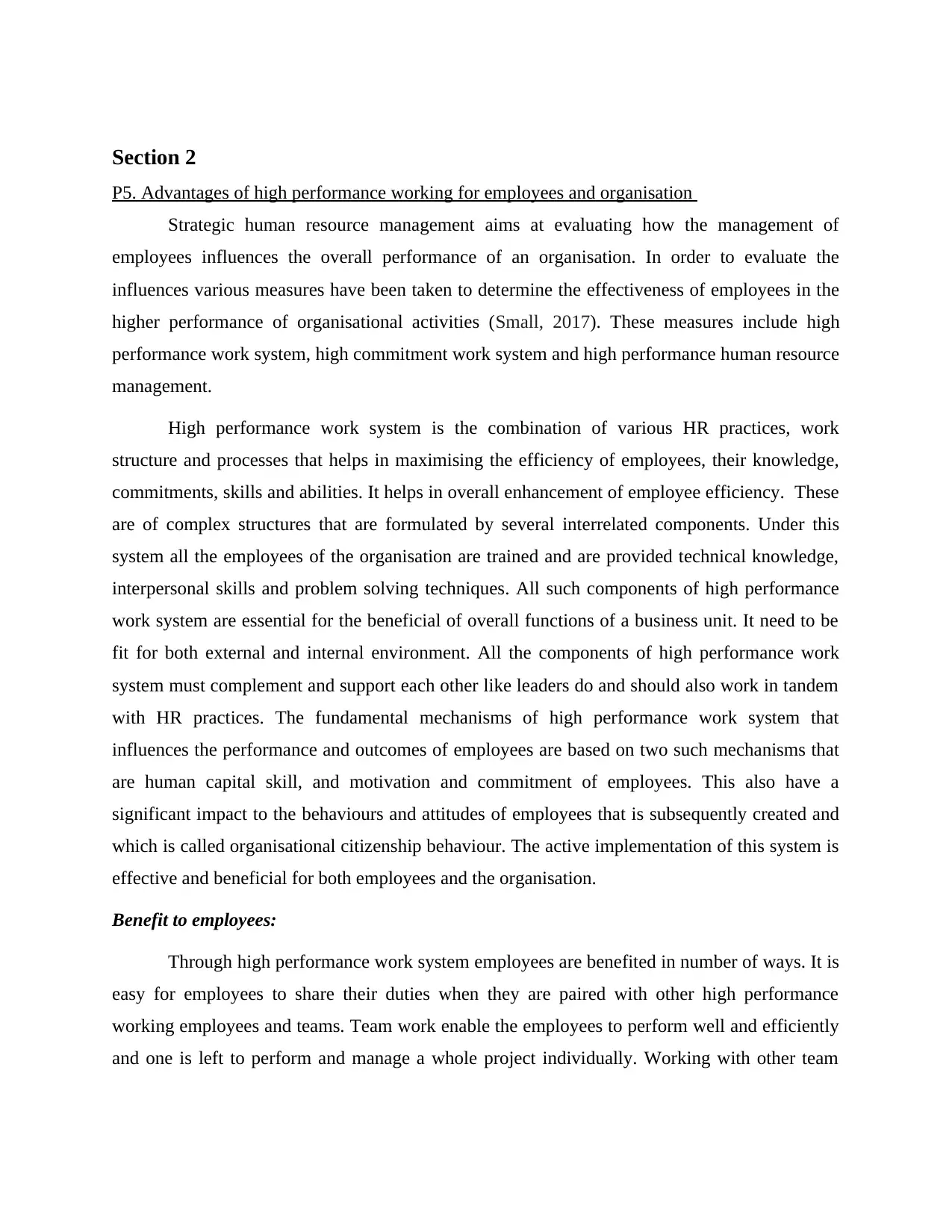
Section 2
P5. Advantages of high performance working for employees and organisation
Strategic human resource management aims at evaluating how the management of
employees influences the overall performance of an organisation. In order to evaluate the
influences various measures have been taken to determine the effectiveness of employees in the
higher performance of organisational activities (Small, 2017). These measures include high
performance work system, high commitment work system and high performance human resource
management.
High performance work system is the combination of various HR practices, work
structure and processes that helps in maximising the efficiency of employees, their knowledge,
commitments, skills and abilities. It helps in overall enhancement of employee efficiency. These
are of complex structures that are formulated by several interrelated components. Under this
system all the employees of the organisation are trained and are provided technical knowledge,
interpersonal skills and problem solving techniques. All such components of high performance
work system are essential for the beneficial of overall functions of a business unit. It need to be
fit for both external and internal environment. All the components of high performance work
system must complement and support each other like leaders do and should also work in tandem
with HR practices. The fundamental mechanisms of high performance work system that
influences the performance and outcomes of employees are based on two such mechanisms that
are human capital skill, and motivation and commitment of employees. This also have a
significant impact to the behaviours and attitudes of employees that is subsequently created and
which is called organisational citizenship behaviour. The active implementation of this system is
effective and beneficial for both employees and the organisation.
Benefit to employees:
Through high performance work system employees are benefited in number of ways. It is
easy for employees to share their duties when they are paired with other high performance
working employees and teams. Team work enable the employees to perform well and efficiently
and one is left to perform and manage a whole project individually. Working with other team
P5. Advantages of high performance working for employees and organisation
Strategic human resource management aims at evaluating how the management of
employees influences the overall performance of an organisation. In order to evaluate the
influences various measures have been taken to determine the effectiveness of employees in the
higher performance of organisational activities (Small, 2017). These measures include high
performance work system, high commitment work system and high performance human resource
management.
High performance work system is the combination of various HR practices, work
structure and processes that helps in maximising the efficiency of employees, their knowledge,
commitments, skills and abilities. It helps in overall enhancement of employee efficiency. These
are of complex structures that are formulated by several interrelated components. Under this
system all the employees of the organisation are trained and are provided technical knowledge,
interpersonal skills and problem solving techniques. All such components of high performance
work system are essential for the beneficial of overall functions of a business unit. It need to be
fit for both external and internal environment. All the components of high performance work
system must complement and support each other like leaders do and should also work in tandem
with HR practices. The fundamental mechanisms of high performance work system that
influences the performance and outcomes of employees are based on two such mechanisms that
are human capital skill, and motivation and commitment of employees. This also have a
significant impact to the behaviours and attitudes of employees that is subsequently created and
which is called organisational citizenship behaviour. The active implementation of this system is
effective and beneficial for both employees and the organisation.
Benefit to employees:
Through high performance work system employees are benefited in number of ways. It is
easy for employees to share their duties when they are paired with other high performance
working employees and teams. Team work enable the employees to perform well and efficiently
and one is left to perform and manage a whole project individually. Working with other team
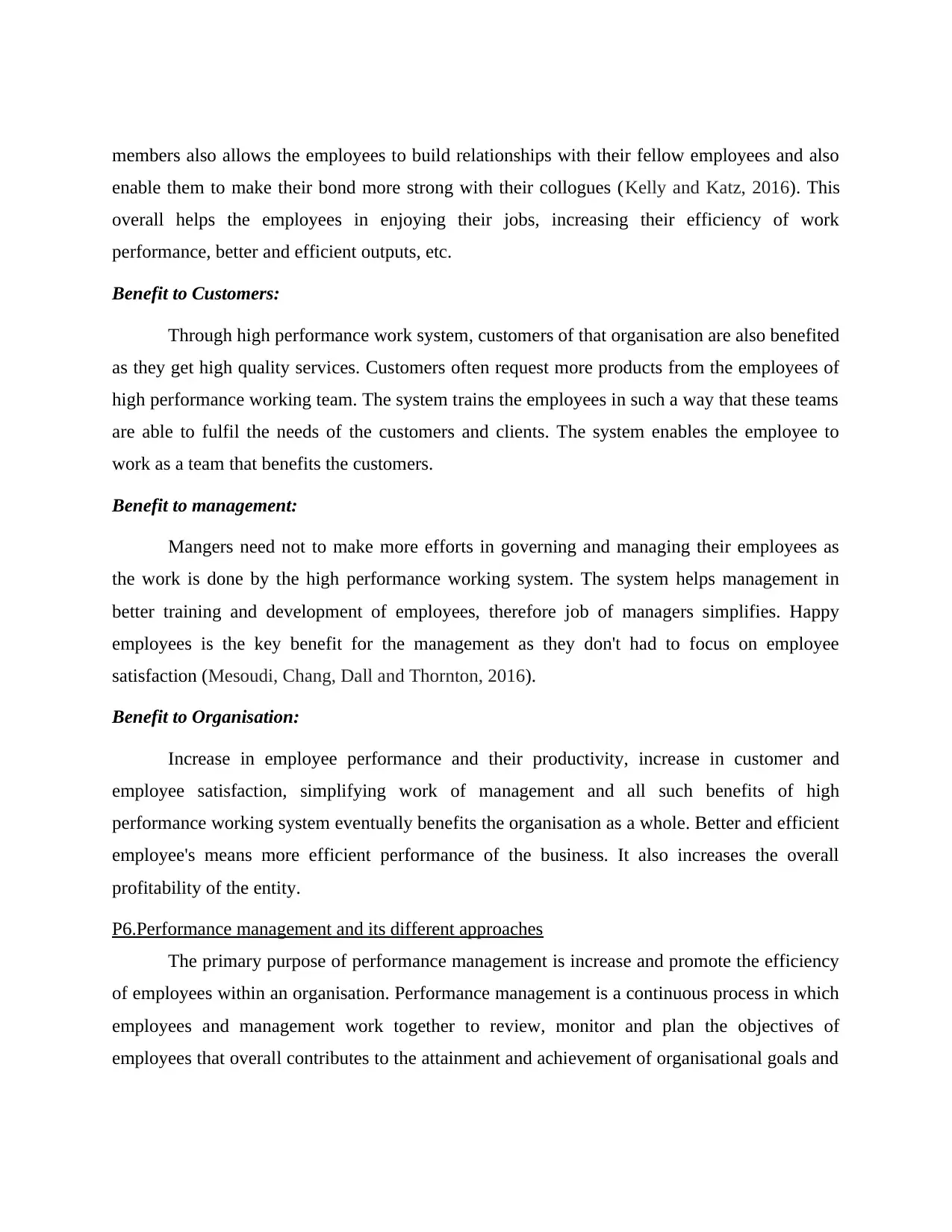
members also allows the employees to build relationships with their fellow employees and also
enable them to make their bond more strong with their collogues (Kelly and Katz, 2016). This
overall helps the employees in enjoying their jobs, increasing their efficiency of work
performance, better and efficient outputs, etc.
Benefit to Customers:
Through high performance work system, customers of that organisation are also benefited
as they get high quality services. Customers often request more products from the employees of
high performance working team. The system trains the employees in such a way that these teams
are able to fulfil the needs of the customers and clients. The system enables the employee to
work as a team that benefits the customers.
Benefit to management:
Mangers need not to make more efforts in governing and managing their employees as
the work is done by the high performance working system. The system helps management in
better training and development of employees, therefore job of managers simplifies. Happy
employees is the key benefit for the management as they don't had to focus on employee
satisfaction (Mesoudi, Chang, Dall and Thornton, 2016).
Benefit to Organisation:
Increase in employee performance and their productivity, increase in customer and
employee satisfaction, simplifying work of management and all such benefits of high
performance working system eventually benefits the organisation as a whole. Better and efficient
employee's means more efficient performance of the business. It also increases the overall
profitability of the entity.
P6.Performance management and its different approaches
The primary purpose of performance management is increase and promote the efficiency
of employees within an organisation. Performance management is a continuous process in which
employees and management work together to review, monitor and plan the objectives of
employees that overall contributes to the attainment and achievement of organisational goals and
enable them to make their bond more strong with their collogues (Kelly and Katz, 2016). This
overall helps the employees in enjoying their jobs, increasing their efficiency of work
performance, better and efficient outputs, etc.
Benefit to Customers:
Through high performance work system, customers of that organisation are also benefited
as they get high quality services. Customers often request more products from the employees of
high performance working team. The system trains the employees in such a way that these teams
are able to fulfil the needs of the customers and clients. The system enables the employee to
work as a team that benefits the customers.
Benefit to management:
Mangers need not to make more efforts in governing and managing their employees as
the work is done by the high performance working system. The system helps management in
better training and development of employees, therefore job of managers simplifies. Happy
employees is the key benefit for the management as they don't had to focus on employee
satisfaction (Mesoudi, Chang, Dall and Thornton, 2016).
Benefit to Organisation:
Increase in employee performance and their productivity, increase in customer and
employee satisfaction, simplifying work of management and all such benefits of high
performance working system eventually benefits the organisation as a whole. Better and efficient
employee's means more efficient performance of the business. It also increases the overall
profitability of the entity.
P6.Performance management and its different approaches
The primary purpose of performance management is increase and promote the efficiency
of employees within an organisation. Performance management is a continuous process in which
employees and management work together to review, monitor and plan the objectives of
employees that overall contributes to the attainment and achievement of organisational goals and
⊘ This is a preview!⊘
Do you want full access?
Subscribe today to unlock all pages.

Trusted by 1+ million students worldwide
1 out of 17
Related Documents
Your All-in-One AI-Powered Toolkit for Academic Success.
+13062052269
info@desklib.com
Available 24*7 on WhatsApp / Email
![[object Object]](/_next/static/media/star-bottom.7253800d.svg)
Unlock your academic potential
Copyright © 2020–2025 A2Z Services. All Rights Reserved. Developed and managed by ZUCOL.





